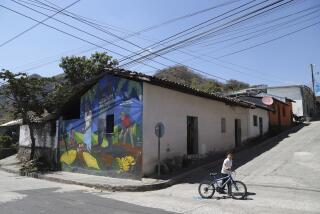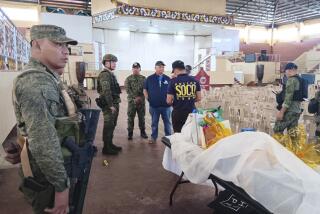Insurgency in Philippines Runs Deeper Than Ideology
MANILA — The strife ravaging the southern Philippines--kidnappings, a long war against separatist guerrillas, an economy torn to shreds--has its roots in what Muslims see as four centuries of discrimination that has denied them social and economic equality.
“Governments have promised us everything,” Salamat Hashim, the 58-year-old leader of Muslim separatists, said last year at his mountaintop stronghold on Mindanao island. “But look around and what is the ‘everything’ they’ve delivered? Do you see roads? Electricity? Economic development? Factories? The everything is nothing.”
The war between the government and Muslim rebels is one of the world’s longest--now in its 29th year--and has claimed more than 120,000 lives. In the last two weeks, 51 Philippine soldiers have been killed and 468 wounded, the government said, as fighting intensified after yearlong peace talks broke down and as a renegade group kidnapped 21 people from a Malaysian resort island.
Western political analysts say the strife in Mindanao--home to most of the predominantly Roman Catholic nation’s 5 million Muslims--represents the biggest crisis of President Joseph Estrada’s two-year administration and is the severest challenge to the stability of the Philippines since a series of coup attempts against President Corazon Aquino between 1986 and 1989. In economic terms alone, the government is paying a huge price: $2.5 million a day to support its soldiers on Mindanao and millions of pesos in lost tax revenue as commerce sputters to a near standstill in parts of the island.
But Western military attaches do not believe that either the ongoing hostage crisis or the intensified fighting has dimmed the chances for peace. For nearly three decades the war has ebbed and surged as combatants fought for territory and negotiating strength. During the latest talks--broken off by the rebels two weeks ago--both sides seemed to accept the fact that there is no military solution in Mindanao, only a political one.
Unlike the Abu Sayyaf rebels, who kidnap as much for money as for ideology, Hashim’s Moro Islamic Liberation Front, or MILF, has a clear political agenda and would probably settle for less than the total independence it demands, analysts say. What it would take to end the rebellion is unclear, but it would certainly involve buckets of cash, a large degree of autonomy, specific guarantees of economic development and amnesty for the MILF’s estimated 12,000 guerrillas.
Estrada, who had hoped to have a peace deal signed by June 30, has taken a tough stand against the separatists: “Independence only over my dead body,” he has said. The president has been criticized by many politicians and diplomats for relying on bellicose rhetoric and speaking of the MILF and Abu Sayyaf as a single entity, whereas most analysts consider the former a politically credible organization and the latter an extremist fringe.
But Estrada also has spent more time on Mindanao, including six trips to Zamboanga city, than any president in decades and has brought the Philippines’ second-largest island a degree of economic development. He realizes, his aides say, that gains by Muslim insurgents could result in a Christian backlash and even risk rekindling the Christian vigilantism that President Ferdinand E. Marcos encouraged in the first days of the war.
“Mindanao is not a Christian-Muslim problem like we’ve seen in parts of Indonesia,” said Father Cornelio Solis, a Catholic priest at St. Anthony’s parish in Zamboanga. “It’s a problem of those who perceive themselves as have-nots. Generally, relations between Christians and Muslims are pretty good. I’ve worked in rebel areas and never had a problem. We’ve held joint prayers for peace.”
Islam, which never spread beyond Mindanao, preceded Christianity to the Philippines. Through nearly 400 years of Spanish and American colonial rule and Japanese occupation, Mindanao remained a hotbed of Muslim insurgency and the country’s only region never brought under full control of foreigners.
As the Philippines advanced economically in recent years, the island grew poorer and more violent. One book advises visitors: “Avoid buses carrying soldiers as they are especially likely to be shot at.”
The conflict intensified in the early 1970s when Marcos centralized authority by declaring martial law throughout the country and ordering individuals to turn in their guns. The largest separatist group, the Moro National Liberation Front, led by Nur Misuari, grew to an armed force of 30,000 men and fought the government until 1996, when the rebels agreed to peace in exchange for a degree of autonomy.
But Hashim’s smaller MILF did not participate in or accept the outcome of negotiations, whereas Misuari became the Manila-appointed governor of a new four-province autonomous zone, assuring him a very comfortable lifestyle, and 5,500 of his guerrillas were integrated into the armed forces. Peace talks with the MILF started last year and were making substantial progress until the latest wave of fighting started in April.
The rebels’ critics, who include virtually all Filipinos outside Mindanao, say the MILF is retarding economic development by scaring away investors and making sites for infrastructure projects insecure. The MILF responds that its actions are taken in self-defense against an increasingly assertive Philippine military.
“The rebels take advantage of every cease-fire,” said Zamboanga Mayor Maria Lobregat, citing the checkpoints around the city of Cotabato that the MILF set up to extort money from motorists. “What investor is going to come to Mindanao if there is extortion and violence and kidnapping?”
Military analysts agree that the armed forces, with about 30,000 troops on Mindanao, could smash the MILF and overrun its base camp, Abu Bakr, if Estrada chose. But that would create the danger of fragmented guerrilla groups on the loose in the jungles, and the government believes that it has a better chance of achieving peace by negotiating with a single, fairly cohesive entity. A deal with the MILF also would isolate the Abu Sayyaf. Although the smaller rebel group has stirred international and domestic outrage with its kidnapping of foreigners, Western diplomats say the Abu Sayyaf is militarily insignificant.
“I think you’ll see peace negotiations get back on track once the hostage crisis is resolved,” said Rodolfo Biazon, former armed forces chief of staff and current chairman of the Philippine Senate’s Security and Defense Committee. “But during any talks, the scenario is likely to be talk-and-fight, marked by lulls and some fairly high levels of combat.”
(BEGIN TEXT OF INFOBOX / INFOGRAPHIC)
Philippine Muslim Groups
The nearly 30-year insurgency in the Philippines’ impoverished southern region of Mindanao has killed more than 120,000 people. The main players:
ABU SAYYAF: Radical band thought to have a core of about 200 fighters and little public support. Now holding two groups of hostages. Splintered from the main rebel group, the Moro National Liberation Front, in 1991.
MORO NATIONAL LIBERATION FRONT: Signed a peace treaty with the government in 1996 after more than 20 years of fighting. Leader Nur Misuari is now governor of a four-province Muslim semiautonomous area on Mindanao, the Philippines’ second-largest island.
MORO ISLAMIC LIBERATION FRONT: Larger of the two groups still fighting. Split from the Moro National Liberation Front in 1978. Leaders include Islamic scholars. Walked out of peace talks with the government in late April, after the army began air and ground attacks on rebels holding a Mindanao highway near their headquarters.
Source: Associated Press
More to Read
Sign up for Essential California
The most important California stories and recommendations in your inbox every morning.
You may occasionally receive promotional content from the Los Angeles Times.










